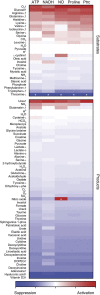Model-driven multi-omic data analysis elucidates metabolic immunomodulators of macrophage activation
- PMID: 22735334
- PMCID: PMC3397418
- DOI: 10.1038/msb.2012.21
Model-driven multi-omic data analysis elucidates metabolic immunomodulators of macrophage activation
Abstract
Macrophages are central players in immune response, manifesting divergent phenotypes to control inflammation and innate immunity through release of cytokines and other signaling factors. Recently, the focus on metabolism has been reemphasized as critical signaling and regulatory pathways of human pathophysiology, ranging from cancer to aging, often converge on metabolic responses. Here, we used genome-scale modeling and multi-omics (transcriptomics, proteomics, and metabolomics) analysis to assess metabolic features that are critical for macrophage activation. We constructed a genome-scale metabolic network for the RAW 264.7 cell line to determine metabolic modulators of activation. Metabolites well-known to be associated with immunoactivation (glucose and arginine) and immunosuppression (tryptophan and vitamin D3) were among the most critical effectors. Intracellular metabolic mechanisms were assessed, identifying a suppressive role for de-novo nucleotide synthesis. Finally, underlying metabolic mechanisms of macrophage activation are identified by analyzing multi-omic data obtained from LPS-stimulated RAW cells in the context of our flux-based predictions. Our study demonstrates metabolism's role in regulating activation may be greater than previously anticipated and elucidates underlying connections between activation and metabolic effectors.
Conflict of interest statement
The authors declare that they have no conflict of interest.
Figures




References
-
- Alldridge LC, Harris HJ, Plevin R, Hannon R, Bryant CE (1999) The annexin protein lipocortin 1 regulates the MAPK/ERK pathway. J Biol Chem 274: 37620–37628 - PubMed
-
- Appelberg R (2006) Macrophage nutriprive antimicrobial mechanisms. J Leukoc Biol 79: 1117–1128 - PubMed
-
- Auberry KJ, Kiebel GR, Monroe ME, Adkins JN, Anderson GA, Smith RD (2010) Omics.pnl.gov: A Portal for the Distribution and Sharing of Multi-Disciplinary Pan-Omics Information. J Proteomics Bioinform 3: 1–4 - PMC - PubMed
-
- Barrett T, Troup DB, Wilhite SE, Ledoux P, Evangelista C, Kim IF, Tomashevsky M, Marshall KA, Phillippy KH, Sherman PM, Muertter RN, Holko M, Ayanbule O, Yefanov A, Soboleva A (2011) NCBI GEO: archive for functional genomics data sets—10 years on. Nucleic Acids Res 39(Database issue) D1005–D1010 - PMC - PubMed
-
- Bassit RA, Sawada LA, Bacurau RF, Navarro F, Martins E Jr., Santos RV, Caperuto EC, Rogeri P, Costa Rosa LF (2002) Branched-chain amino acid supplementation and the immune response of long-distance athletes. Nutrition 18: 376–379 - PubMed
Publication types
MeSH terms
Substances
Grants and funding
LinkOut - more resources
Full Text Sources
Other Literature Sources
Molecular Biology Databases
Research Materials

